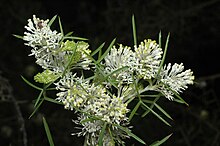| Grevillea triloba | |
|---|---|

| |
| In the Australian National Botanic Gardens | |
| Conservation status | |
 Priority Three — Poorly Known Taxa (DEC) | |
| Scientific classification | |
| Kingdom: | Plantae |
| Clade: | Tracheophytes |
| Clade: | Angiosperms |
| Clade: | Eudicots |
| Order: | Proteales |
| Family: | Proteaceae |
| Genus: | Grevillea |
| Species: | G. triloba |
| Binomial name | |
| Grevillea triloba Meisn. | |
Grevillea triloba is species of flowering plant in the family Proteaceae and is endemic to near Geraldton in Western Australia. It is a diffuse or spreading shrub, usually with divided leaves with 3 spreading, linear lobes, and clusters of white flowers.
Description
Grevillea trilobais a diffuse or spreading shrub that typically grows to a height of 0.9–1.5 m (2 ft 11 in – 4 ft 11 in), its branchlets woolly- to shaggy-hairy. The leaves are usually divided, 30–70 mm (1.2–2.8 in) long, usually with 3 spreading lobes 12–43 mm (0.47–1.69 in) long, 1–4.5 mm (0.039–0.177 in) wide. Sometimes the leaves are broadly linear and 3–8 mm (0.12–0.31 in) wide. The edges of the leaves are turned down to rolled under without concealing the woolly-hairy lower surface. The flowers are arranged in conical to more or less cylindrical clusters on a woolly-hairy rachis, the flowers nearer the base of the rachis flowering first. The flowers are white or pinkish, the pistil 3.6–4.3 mm (0.14–0.17 in) long. Flowering mainly occurs from July to October, and the fruit is an oblong to elliptic follicle 8–10 mm (0.31–0.39 in) long with a wrinkled surface.
Taxonomy
Grevillea triloba was first formally described by the botanist Carl Meissner in 1855 in William Jackson Hooker's Journal of Botany and Kew Garden Miscellany from specimens collected by James Drummond.
The specific epithet (triloba) means "three-lobed", referring to the leaves.
Distribution
This grevillea grows in heath and shrubby woodland in sandy loam or lateritic soils in near-coastal areas from Geraldton to near Northampton in the Geraldton Sandplains bioregion of Western Australia.
Conservation status
Grevillea triloba is listed as "Priority Three" by the Government of Western Australia Department of Biodiversity, Conservation and Attractions, meaning that it is poorly known and known from only a few locations but is not under imminent threat.
Use in horticulture
Commonly cultivated, G. triloba is a vigorous plant that is suited to most soils and aspects. The prickly leaves make it suitable as a screening plant.
See also
References
- ^ "Grevillea triloba". Australian Plant Census. Retrieved 28 March 2023.
- ^ "Grevillea triloba". Australian Biological Resources Study, Department of Agriculture, Water and the Environment: Canberra. Retrieved 28 March 2023.
- ^ "Grevillea triloba". FloraBase. Western Australian Government Department of Biodiversity, Conservation and Attractions.
- ^ Wrigley, John W.; Fagg, Murray A. (1991). Banksias, waratahs & grevilleas : and all other plants in the Australian Proteaceae family. North Ryde, NSW, Australia: Angus & Robertson. pp. 343–344. ISBN 0207172773.
- "Grevillea triloba". APNI. Retrieved 28 March 2023.
- Meissner, Carl (1855). Hooker, William J. (ed.). "New proteaceae of Australia". Hooker's Journal of Botany and Kew Garden Miscellany. 7: 74. Retrieved 28 March 2023.
- Sharr, Francis Aubi; George, Alex (2019). Western Australian Plant Names and Their Meanings (3rd ed.). Kardinya, WA: Four Gables Press. p. 327. ISBN 9780958034180.
- "Conservation codes for Western Australian Flora and Fauna" (PDF). Government of Western Australia Department of Parks and Wildlife. Retrieved 28 March 2023.
| Taxon identifiers | |
|---|---|
| Grevillea triloba | |